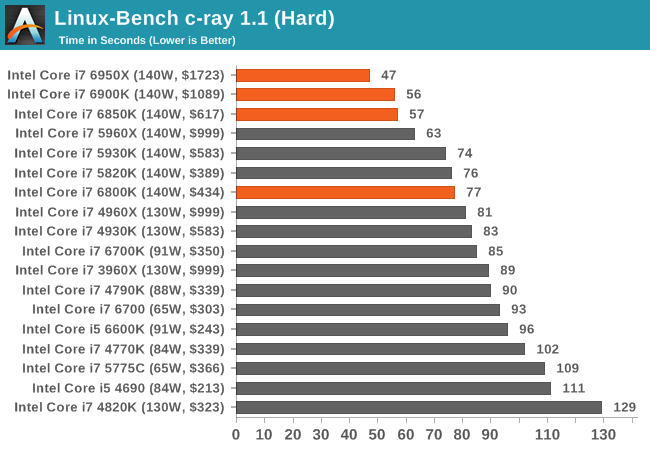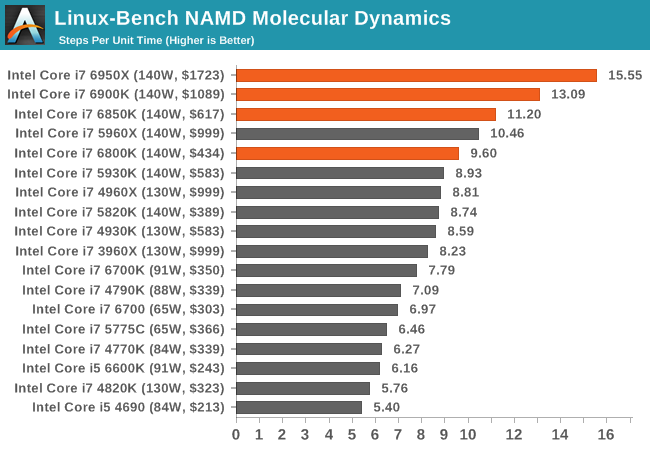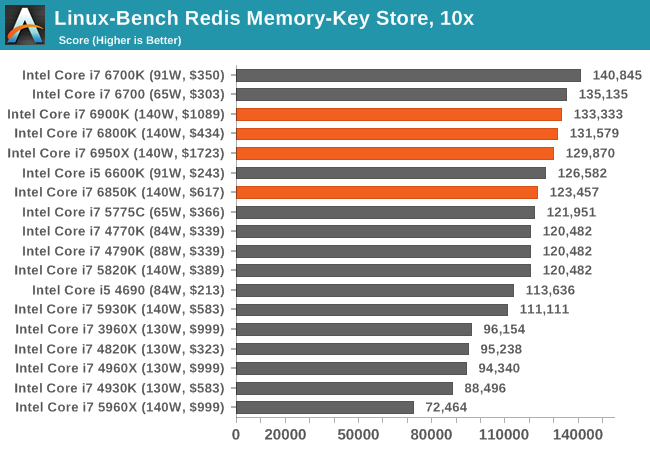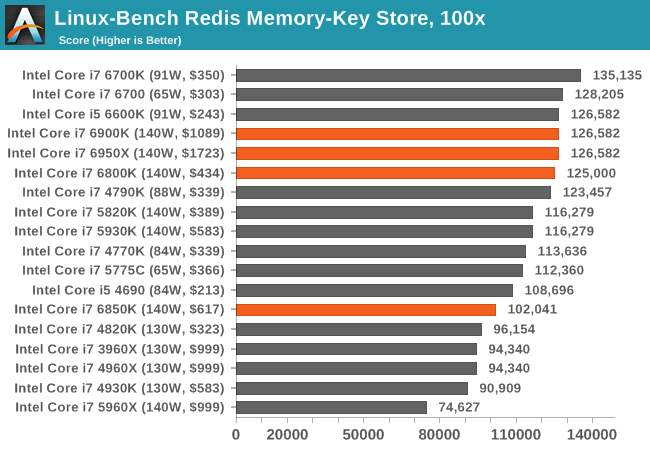The Intel Broadwell-E Review: Core i7-6950X, i7-6900K, i7-6850K and i7-6800K Tested
by Ian Cutress on May 31, 2016 2:01 AM EST- Posted in
- CPUs
- Intel
- Enterprise
- Prosumer
- X99
- 14nm
- Broadwell-E
- HEDT
Linux Performance
Built around several freely available benchmarks for Linux, Linux-Bench is a project spearheaded by Patrick at ServeTheHome to streamline about a dozen of these tests in a single neat package run via a set of three commands using an Ubuntu 11.04 LiveCD. These tests include fluid dynamics used by NASA, ray-tracing, OpenSSL, molecular modeling, and a scalable data structure server for web deployments. We run Linux-Bench and have chosen to report a select few of the tests that rely on CPU and DRAM speed.
C-Ray: link
C-Ray is a simple ray-tracing program that focuses almost exclusively on processor performance rather than DRAM access. The test in Linux-Bench renders a heavy complex scene offering a large scalable scenario.

NAMD, Scalable Molecular Dynamics: link
Developed by the Theoretical and Computational Biophysics Group at the University of Illinois at Urbana-Champaign, NAMD is a set of parallel molecular dynamics codes for extreme parallelization up to and beyond 200,000 cores. The reference paper detailing NAMD has over 4000 citations, and our testing runs a small simulation where the calculation steps per unit time is the output vector.

Redis: link
Many of the online applications rely on key-value caches and data structure servers to operate. Redis is an open-source, scalable web technology with a strong developer base, but also relies heavily on memory bandwidth as well as CPU performance.
[words]












205 Comments
View All Comments
h4gfish - Monday, June 13, 2016 - link
> This combination of colors tends to go down well with whoever loves gold,> perhaps indicating that Intel is looking at a new kind of premium customer.
Whom do you mean by this 'new kind of premium customer'? Indians? Middle easterners? New York Italians? Rap stars? Or is it just that enterprise buyers don't tend to pay much attention to packaging? Maybe it's just me and my stereotypes, but I heard a 'sneer' in that sentence that is possibly unintentional.
Witek - Thursday, June 16, 2016 - link
I still think overclocked i7-3930K provides awesome value, 6850K is more expensive, absymally faster, and not that much more power efficient. Only good reason is if you care about AVX2, few additional special instructions (like ADDX, FMA3, etc), improves AES speeds and random numbers generation, or PCI 3.0 (3930K only supports PCI 2.0). But in generic applications speed improvements are 10-15% on average. Not worth 2-3 times money.The price of 6950X is a joke, and it is better probably to get some Xeon (or two) at that price point. I understand making these chips is very expensive, but it is not practical to sell them at these prices.
SanX - Tuesday, June 21, 2016 - link
Did I correctly understood this article mentions that if you use AVX instructions then overclocked freq must be up to 300 MHz less, which basically means that overclock is not possible? And did Ian use water cooling or all was on air?SlyNine - Wednesday, June 22, 2016 - link
Pick up chicks easier. They loves the core count.spooh - Thursday, August 4, 2016 - link
Any clues, if Anniversary update supports Turbo Boost Max?